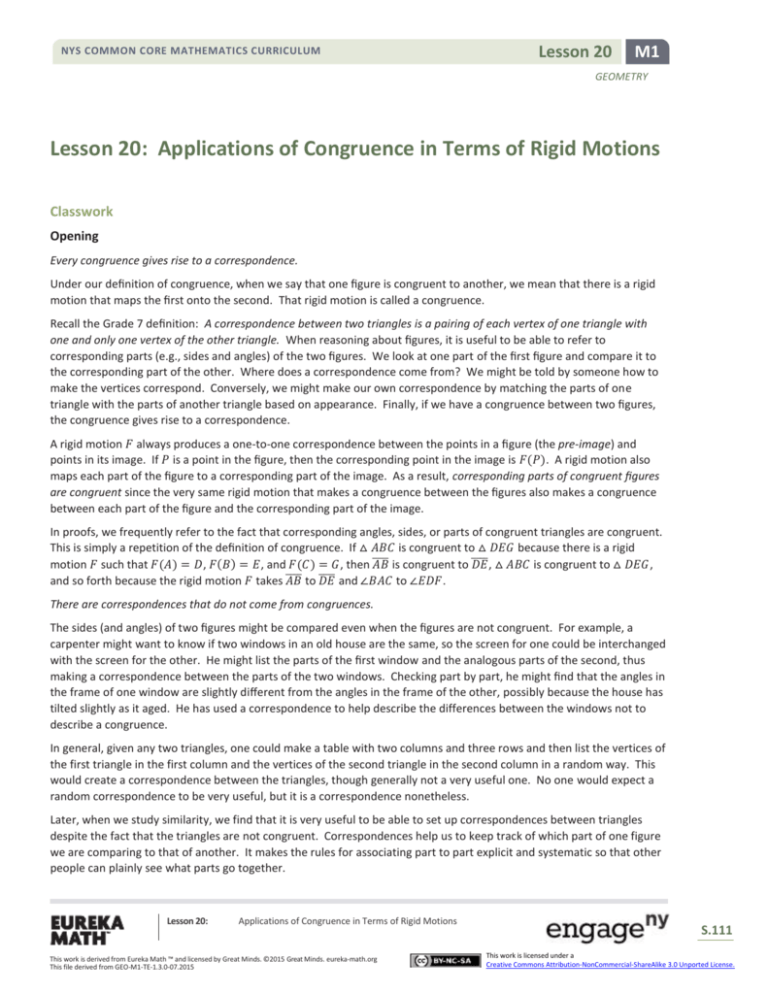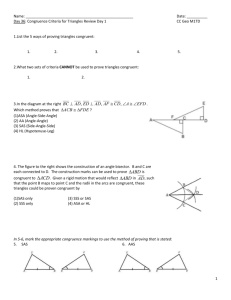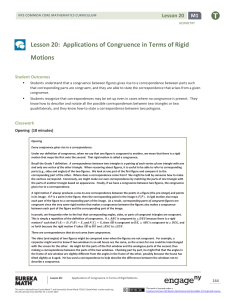Lesson 20 - EngageNY
advertisement

NYS COMMON CORE MATHEMATICS CURRICULUM Lesson 20 M1 GEOMETRY Lesson 20: Applications of Congruence in Terms of Rigid Motions Classwork Opening Every congruence gives rise to a correspondence. Under our definition of congruence, when we say that one figure is congruent to another, we mean that there is a rigid motion that maps the first onto the second. That rigid motion is called a congruence. Recall the Grade 7 definition: A correspondence between two triangles is a pairing of each vertex of one triangle with one and only one vertex of the other triangle. When reasoning about figures, it is useful to be able to refer to corresponding parts (e.g., sides and angles) of the two figures. We look at one part of the first figure and compare it to the corresponding part of the other. Where does a correspondence come from? We might be told by someone how to make the vertices correspond. Conversely, we might make our own correspondence by matching the parts of one triangle with the parts of another triangle based on appearance. Finally, if we have a congruence between two figures, the congruence gives rise to a correspondence. A rigid motion 𝐹 always produces a one-to-one correspondence between the points in a figure (the pre-image) and points in its image. If 𝑃 is a point in the figure, then the corresponding point in the image is 𝐹(𝑃). A rigid motion also maps each part of the figure to a corresponding part of the image. As a result, corresponding parts of congruent figures are congruent since the very same rigid motion that makes a congruence between the figures also makes a congruence between each part of the figure and the corresponding part of the image. In proofs, we frequently refer to the fact that corresponding angles, sides, or parts of congruent triangles are congruent. This is simply a repetition of the definition of congruence. If △ 𝐴𝐵𝐶 is congruent to △ 𝐷𝐸𝐺 because there is a rigid motion 𝐹 such that 𝐹(𝐴) = 𝐷, 𝐹(𝐵) = 𝐸, and 𝐹(𝐶) = 𝐺, then ̅̅̅̅ 𝐴𝐵 is congruent to ̅̅̅̅ 𝐷𝐸 , △ 𝐴𝐵𝐶 is congruent to △ 𝐷𝐸𝐺, and so forth because the rigid motion 𝐹 takes ̅̅̅̅ 𝐴𝐵 to ̅̅̅̅ 𝐷𝐸 and ∠𝐵𝐴𝐶 to ∠𝐸𝐷𝐹. There are correspondences that do not come from congruences. The sides (and angles) of two figures might be compared even when the figures are not congruent. For example, a carpenter might want to know if two windows in an old house are the same, so the screen for one could be interchanged with the screen for the other. He might list the parts of the first window and the analogous parts of the second, thus making a correspondence between the parts of the two windows. Checking part by part, he might find that the angles in the frame of one window are slightly different from the angles in the frame of the other, possibly because the house has tilted slightly as it aged. He has used a correspondence to help describe the differences between the windows not to describe a congruence. In general, given any two triangles, one could make a table with two columns and three rows and then list the vertices of the first triangle in the first column and the vertices of the second triangle in the second column in a random way. This would create a correspondence between the triangles, though generally not a very useful one. No one would expect a random correspondence to be very useful, but it is a correspondence nonetheless. Later, when we study similarity, we find that it is very useful to be able to set up correspondences between triangles despite the fact that the triangles are not congruent. Correspondences help us to keep track of which part of one figure we are comparing to that of another. It makes the rules for associating part to part explicit and systematic so that other people can plainly see what parts go together. Lesson 20: Applications of Congruence in Terms of Rigid Motions This work is derived from Eureka Math ™ and licensed by Great Minds. ©2015 Great Minds. eureka-math.org This file derived from GEO-M1-TE-1.3.0-07.2015 S.111 This work is licensed under a Creative Commons Attribution-NonCommercial-ShareAlike 3.0 Unported License. Lesson 20 NYS COMMON CORE MATHEMATICS CURRICULUM M1 GEOMETRY Discussion Let’s review function notation for rigid motions. a. To name a translation, we use the symbol 𝑇⃗⃗⃗⃗⃗ 𝐴𝐵 . We use the letter 𝑇 to signify that we are referring to a translation and the letters 𝐴 and 𝐵 to indicate the translation that moves each point in the direction from 𝐴 to 𝐵 along a line parallel to line 𝐴𝐵 by distance 𝐴𝐵. The image of a point 𝑃 is denoted 𝑇⃗⃗⃗⃗⃗ 𝐴𝐵 (𝑃). Specifically, (𝐴) 𝑇𝐴𝐵 = 𝐵. ⃗⃗⃗⃗⃗ b. To name a reflection, we use the symbol 𝑟𝑙 , where 𝑙 is the line of reflection. The image of a point 𝑃 is denoted 𝑟𝑙 (𝑃). In particular, if 𝐴 is a point on 𝑙, 𝑟𝑙 (𝐴) = 𝐴. For any point 𝑃, line 𝑙 is the perpendicular bisector of segment 𝑃𝑟𝑙 (𝑃). c. To name a rotation, we use the symbol 𝑅𝐶,𝑥° to remind us of the word rotation. 𝐶 is the center point of the rotation, and 𝑥 represents the degree of the rotation counterclockwise around the center point. Note that a positive degree measure refers to a counterclockwise rotation, while a negative degree measure refers to a clockwise rotation. Example 1 In each figure below, the triangle on the left has been mapped to the one on the right by a 240° rotation about 𝑃. Identify all six pairs of corresponding parts (vertices and sides). Corresponding Vertices Corresponding Sides What rigid motion mapped △ 𝐴𝐵𝐶 onto △ 𝑋𝑌𝑍? Write the transformation in function notation. Lesson 20: Applications of Congruence in Terms of Rigid Motions This work is derived from Eureka Math ™ and licensed by Great Minds. ©2015 Great Minds. eureka-math.org This file derived from GEO-M1-TE-1.3.0-07.2015 S.112 This work is licensed under a Creative Commons Attribution-NonCommercial-ShareAlike 3.0 Unported License. NYS COMMON CORE MATHEMATICS CURRICULUM Lesson 20 M1 GEOMETRY Example 2 Given a triangle with vertices 𝐴, 𝐵, and 𝐶, list all the possible correspondences of the triangle with itself. Example 3 Give an example of two quadrilaterals and a correspondence between their vertices such that (a) corresponding sides are congruent, but (b) corresponding angles are not congruent. Lesson 20: Applications of Congruence in Terms of Rigid Motions This work is derived from Eureka Math ™ and licensed by Great Minds. ©2015 Great Minds. eureka-math.org This file derived from GEO-M1-TE-1.3.0-07.2015 S.113 This work is licensed under a Creative Commons Attribution-NonCommercial-ShareAlike 3.0 Unported License. Lesson 20 NYS COMMON CORE MATHEMATICS CURRICULUM M1 GEOMETRY Problem Set 1. Given two triangles, one with vertices 𝐴, 𝐵, and 𝐶, and the other with vertices 𝑋, 𝑌, and 𝑍, there are six different correspondences of the first with the second. a. One such correspondence is the following: 𝐴→𝑍 𝐵→𝑋 𝐶→𝑌 Write the other five correspondences. b. If all six of these correspondences come from congruences, then what can you say about △ 𝐴𝐵𝐶? c. If two of the correspondences come from congruences, but the others do not, then what can you say about △ 𝐴𝐵𝐶 ? d. Why can there be no two triangles where three of the correspondences come from congruences, but the others do not? 2. Give an example of two triangles and a correspondence between them such that (a) all three corresponding angles are congruent, but (b) corresponding sides are not congruent. 3. Give an example of two triangles and a correspondence between their vertices such that (a) one angle in the first is congruent to the corresponding angle in the second, and (b) two sides of the first are congruent to the corresponding sides of the second, but (c) the triangles themselves are not congruent. 4. Give an example of two quadrilaterals and a correspondence between their vertices such that (a) all four corresponding angles are congruent, and (b) two sides of the first are congruent to two sides of the second, but (c) the two quadrilaterals are not congruent. 5. A particular rigid motion, 𝑀, takes point 𝑃 as input and gives point 𝑃′ as output. That is, 𝑀(𝑃) = 𝑃′. The same rigid motion maps point 𝑄 to point 𝑄′. Since rigid motions preserve distance, is it reasonable to state that 𝑃𝑃′ = 𝑄𝑄′? Does it matter which type of rigid motion 𝑀 is? Justify your response for each of the three types of rigid motion. Be specific. If it is indeed the case, for some class of transformations, that 𝑃𝑃′ = 𝑄𝑄′ is true for all 𝑃 and 𝑄, explain why. If not, offer a counterexample. Lesson 20: Applications of Congruence in Terms of Rigid Motions This work is derived from Eureka Math ™ and licensed by Great Minds. ©2015 Great Minds. eureka-math.org This file derived from GEO-M1-TE-1.3.0-07.2015 S.114 This work is licensed under a Creative Commons Attribution-NonCommercial-ShareAlike 3.0 Unported License.




